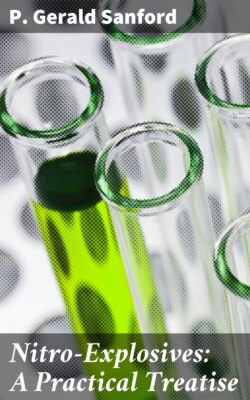Читать книгу Nitro-Explosives: A Practical Treatise - P. Gerald Sanford - Страница 20
На сайте Литреса книга снята с продажи.
|ONO_{2} C_{3}H_{5}|OH; |OH
Оглавлениеand if the three atoms are displaced, C_{3}H_{5}(ONO_{2})_{3}, or the tri- nitrate, is formed, which is commercial nitro-glycerine.
Another class, the nitro-celluloses, are formed from cellulose, C_{6}H_{10}O_{5}, which forms the groundwork of all vegetable tissues. Cellulose has some of the properties of the alcohols, and forms ethereal salts when treated with nitric and sulphuric acids. The hexa-nitrate, or gun-cotton, has the formula, C_{12}H_{14}O_{4}(ONO_{2})_{6}; and collodion-cotton, pyroxylin, &c., form the lower nitrates, i.e., the tetra- and penta-nitrates. These last are soluble in various solvents, such as ether-alcohol and nitro-glycerine, in which the hexa-nitrate is insoluble. They all dissolve, however, in acetone and acetic ether.
The solution of the soluble varieties in ether-alcohol is known as collodion, which finds many applications in the arts. The hydrocarbon benzene, C_{6}H_{6}, prepared from the light oil obtained from coal-tar, when nitrated forms nitro-benzenes, such as mono-nitro-benzene, C_{6}H_{5}NO_{2}, and di-nitro-benzene, C_{6}H_{4}(NO_{2}){2}, in which one and two atoms are replaced by the NO{2} group. The latter of these compounds is used as an explosive, and enters into the composition of such well-known explosives as roburite, &c. The presence of nitro groups in a substance increases the difficulty of further nitration, and in any case not more than three nitro groups can be introduced into an aromatic compound, or the phenols. All aromatic compounds with the general formula, C_{6}H_{4}X_{2}, give, however, three series. They are called ortho, meta, or para compounds, depending upon the position of NO_{2} groups introduced.
Certain regularities have been observed in the formation of nitro- compounds. If, for example, a substance contains alkyl or hydroxyl groups, large quantities of the para compound are obtained, and very little of the ortho. The substitution takes place, however, almost entirely in the meta position, if a nitro, carboxyl, or aldehyde group be present. Ordinary phenol, C_{6}H_{5}.OH, gives para- and ortho-nitro-phenol; toluene gives para- and ortho-nitro-toluene; but nitro-benzene forms meta-di-nitro- benzene and benzoic acid, meta-nitro-benzoic acid.[A]
[Footnote A: "Organic Chemistry," Prof. Hjelt. Translated by J.B. Tingle,
PhD.]
If the graphic formula of benzene be represented thus (No. 1), then the positions 1 and 2 represent the ortho, 1 and 3 the meta, and 1 and 4 the para compounds. When the body phenol, C_{6}H_{5}.OH, is nitrated, a compound is formed known as tri-nitro-phenol, or picric acid, C_{6}H_{2}(NO_{2}){3}OH, which is used very extensively as an explosive, both as picric acid and in the form of picrates. Another nitro body that is used as an explosive is nitro-naphthalene, C{10}H_{6}(NO_{2}){2}, in roburite, securite, and other explosives of this class. The hexa-nitro- mannite, C{6}H_{8}(ONO_{2})_{6}, is formed
[Illustration: No. 1]
[Illustration: META-DINITRO-BENZENE No.2]
by treating a substance known as mannite, C_{6}H_{8}(OH)_{6}, an alcohol formed by the lactic acid fermentation of sugar and closely related to the sugars, with nitric and sulphuric acids. It is a solid substance, and very explosive; it contains 18.58 per cent. of nitrogen.
Nitro-starch has also been used for the manufacture of an explosive. Muhlhauer has described (Ding. Poly. Jour., 73, 137–143) three nitric ethers of starch, the tetra-nitro-starch, C_{12}H_{16}O_{6}(ONO_{2})_{4}, the penta- and hexa-nitro-starch. They are formed by acting upon potato starch dried at 100° C. with a mixture of nitric and sulphuric acids at a temperature of 20° to 25° C. Rice starch has also been used in its production. Muhlhauer proposes to use this body as a smokeless powder, and to nitrate it with the spent mixed acids from the manufacture of nitro- glycerine. This substance contains from 10.96 to 11.09 per cent. of nitrogen. It is a white substance, very stable and soluble even in cold nitro-glycerine.
The explosive bodies formed by the nitration of jute have been studied by Messrs Cross and Bevan. and also by Mühlhäuer. The former chemists give jute the formula C_{12}H_{18}O_{9}, and believe that its conversion into a nitro-compound takes place according to the equation—
